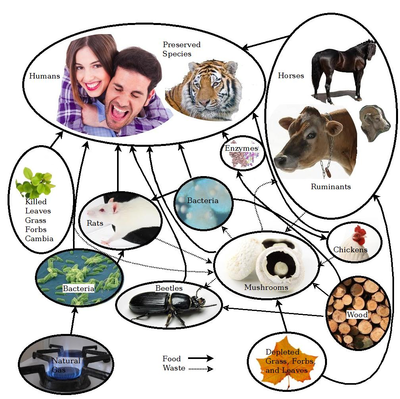Source
- Seth D. Baum, David C. Denkenberger, Joshua M. Pearce. Alternative Foods as a Solution to Global Food Supply Catastrophes, Solutions 7(4): 31-35 (2016). open access

Abstract
Analysis of future food security typically focuses on managing gradual trends such as population growth, natural resource depletion, and environmental degradation. However, several risks threaten to cause large and abrupt declines in food security. For example, nuclear war, volcanic eruptions, and asteroid impact events can block sunlight, causing abrupt global cooling. In extreme but entirely possible cases, these events could make agriculture infeasible worldwide for several years, creating a food supply catastrophe of historic proportions. This paper describes alternative foods that use non-solar energy inputs as a solution for these catastrophes. For example, trees can be used to grow mushrooms; natural gas can feed certain edible bacteria. Alternative foods are already in production today, but would need to be dramatically scaled up to become the primary food source during a global food supply catastrophe. Scale-up would require extensive depletion of natural resources and difficult social coordination. For these reasons, large-scale use of alternative foods should be considered only for desperate circumstances of food supply catastrophes. During a catastrophe, alternative foods may be the only solution capable of preventing massive famine and maintaining human civilization. Furthermore, elements of alternative foods may be applicable to non-catastrophe times, such growing mushrooms on logging residues. Society should include alternative foods as part of its contingency planning for food supply catastrophes and possibly during normal times as well.
See Also
| Feeding Everyone No Matter What |
|---|
Error in widget YouTube: Unable to load template 'wiki:YouTube' |

- Feeding Everyone No Matter What - The full book main page
- David Denkenberger and Joshua Pearce, Feeding Everyone No Matter What: Managing Food Security After Global Catastrophe , 1st Edition, Academic Press, 2015
- Free Preview: Google books
- Cover on Academia
- Facebook page
- Resilience to global food supply catastrophes
- Feeding Everyone if the Sun is Obscured and Industry is Disabled
- Cost-Effectiveness of Interventions for Alternate Food to Address Agricultural Catastrophes Globally
- Dave Denkenberger Publications
- Feeding Everyone: Solving the Food Crisis in Event of Global Catastrophes that Kill Crops or Obscure the Sun
- OSE Wiki "Synfood" (i.e. protein and other dietary components from microbial organisms fed on gas or other hydrocarbons)





